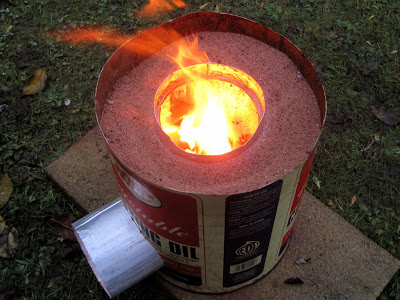[Simon], a gardener in the United Kingdom, created this super cheap and easy to build rocket stove. The great thing about this little guy is that the methods and materials used to create it are so basic, anyone should be able to quickly make their own for just a few bucks. If nothing else, this is a good introductory project for people wanting to experiment with these stoves.
The only materials required are a metal 5 gallon cooking oil drum, a few scrap pieces of chimney liner pipe, and some sand. That’s it.
[Simon] cut off the top of the oil drum and made a hole in the front to fit the pipe. He then trimmed the scrap pieces of pipe to form a 90 degree elbow and positioned that in place inside the drum. Sand poured around the pipe acted as the insulator. Finally, he cut and flattened a scrap piece of pipe to use as a front loading tray for the wood.
Simple as that. Party on.
[via The Flying Tortoise]















Looks pretty toasty. If you were to retrofit a removable forced air supply (a blower or some other small fan) to your feeding chute you could achieve more heat.
no need, the point is that the heat creates its draft up the chimney. elegant as it is.
Lots of interesting rocket stoves here: http://www.flickr.com/groups/877622@N25/pool
i learned this from jmemantzel video.. works great.
haha, and remember, chimney liner, not stove pipe!
Nice design, i’ll definitely be trying it or something similar!
Check out a Smudge Pot, or Orchard Heater. They pump out a lot of heat, and should be fairly easy to add a cooking surface to.
Are orchard heaters still available in the USA? The oilfield supply stores said they can longer get them some years ago. Oil well servicing rig crews used them, where gas coming out of the well wasn’t present. I’m guessing they now use a heater using propane wood burners. Right now propane is cheaper per gallon than diesel & less a PIA to mess with in the field.
I’ll give it a try today afternoon.
It’l may be funny to drive an blowing-fan with an peltier-element *G
I wonder how do he remove hashes from inside the chamber not being able to tip the stove over without spilling the sand
By the way he joined the pipes it seems he is going to have quite a bit of waste permanently sitting at the bottom (which is lower than the feeding port)
When the stove goes out, he can blow them out from above, scraping with a stick from below.
5 gallon? or 20 liter?
They’re about the same. Presumably for the benefit of Americans who still use the obsolete and bizarre Imperial system of weights and measures (and have the cheek to refer to it as the “English” system!), HAD specifies gallons. The maker’s own site also specifies gallons and he’s British, but perhaps he’s old and not caught up to the system we’ve all been using for the last 30 years.
But yeah being sold in the EU, the oil container is probably a 20 litre one. Or at least contained 20 litres of oil. Who knows how much extra air there was in there when it was new? Does it matter?
As far as American ‘cheek’ goes you’re being a little unfair. Sixteen ounce pints were standard in the UK for a fair while after the founding of America. The later increase to twenty ounces was to simplify the maths of shipping. At the same time they changed the length of the furlong and buggered up distance as well.
I built one to play with a couple winters ago, just stacking up some old firebrick and packing sand in as mortar to seal it up. Quite neat! After a couple of minutes it doesn’t even smell like a wood fire, the smoke (and smell I guess) is all consumed in the combustion process. As far as ashes go, there isn’t much to speak of. Ashes and smoke are symptoms of incomplete combustion, and this thing burns unbelievably clean. What came out of the stack wasn’t smoke. It was water vapor, or low temperature steam.
The sand isn’t a very good insulator. I’ve tried it in an aluminum furnace. Sucks. A $4 bag of perlite from the Wal-Mart garden center works amazingly well. It’s what I use anymore for low temp (below 2000 F) furnaces.
For best results (higher efficiency) the chimney should be surrounded with the best insulator with the lowest thermal mass. Vermiculite or perlite worked better than sand in the one i made (and much much lighter). The higher the thermal mass, the longer it will take the chimney to get to max temp and thus create the strongest updraft.
Oops, rallen beat me to it.
is combustion still legal in EWWW (I mean EU) countries?
Nope. All cars in the EU run on sound political financial decisions, Elven magic, and the wit of Graham Norton.
Let’s not get US side-o-the-pind, 231 cu in gallons mixed up with those giant Imperial gallons the Brits once used. We use democratic-republican gallons, and have pints to fit them in our public houses. What’s imperial us tryingnto ram cc’s down our throat and then suddenly tell us, no, those are ml’s. Blimey…
????